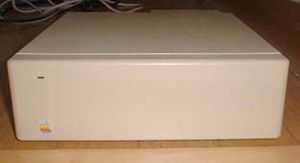Hard Disk 20
 | |
| Type | Hard Disk |
|---|---|
| Release date | September 17, 1985 |
| Introductory price | 1499 [1] |
| Discontinued | September 1987 |
| Operating system | 2.1–4.3 |
| Dimensions | plastic (Pantone 453[2]) |
The Macintosh Hard Disk 20 is the first hard drive developed by Apple Computer specifically for use with the Macintosh 512K. Introduced on September 17, 1985, it was part of Apple's long awaited solution toward completing the Macintosh Office (a suite of integrated business hardware & software) announced in January 1985. It would be over a year more before Apple would release the file server software AppleShare that would link all of the hardware together. By that time the SCSI interface introduced on the Macintosh Plus in January 1986, would accommodate far faster and more efficient hard drives, rendering the Hard Disk 20 virtually obsolete.[3]
Features
The Hard Disk 20 (or HD20, as it was known colloquially) contained a 20MB 3.5" Rodime hard disk which provided over 50 times the data storage of the stock 400K disk drive. At a time when the average file size was around 10-20K and due to the vast number of those files the HD 20 could contain, Apple's original Macintosh File System, which did not allow for directories, would have made organizing those files unwieldy. Therefore Apple introduced it with a new System and Finder update which included the brand new Hierarchical File System allowing the user to better organize files on such a large volume. As a result only the Macintosh 512K could access it; the original Macintosh 128K did not have enough RAM to load the new file system. In fact, even for the Macintosh 512K to use the drive, it required an additional file in the System Folder on a special startup disk which added additional code into memory during startup. An ingenious startup routine also allowed the Mac to check for the presence of a System file on the Hard Disk, switch over to it and eject the startup disk. Unfortunately, the HD 20 could not be used as a startup disk directly without first loading the code from the floppy disk drive. With the release of the Macintosh Plus and the Macintosh 512Ke, both containing the upgraded 128K ROM which contained the additional code, the HD 20 could finally be used alone as a startup disk.
While other hard drives were available on the market, Apple's HD 20 was generally preferred mainly because Apple broke their own development rules when they offered it. Originally the Macintosh was designed with two serial ports which were to meet all the expansion needs of the user. It also included a dedicated floppy disk port for one external floppy disk. Most of the hard drives which were available on the market used the slower serial port to transfer data per Apple's specifications. Apple instead engineered the HD 20 to use the faster floppy disk port, enabling the user to daisy-chain an external floppy disk drive as well as an additional HD 20. With few exceptions, this along with complete compatibility with the new Hierarchical File System, gave Apple an instant edge over the competition. In addition, the HD 20 had a convenient "zero-footprint" design which fit precisely underneath the Macintosh, merely elevating it 3 inches, but otherwise taking up no more desk-space.[4]
History
In 1985, the HD 20 was an important step to solidifying the Macintosh as a true business computer and it was eagerly anticipated following its April announcement. Until Apple's introduction a year later of the Hard Disk 20SC, the first SCSI drive they manufactured, the HD 20 was the only Apple-manufactured hard drive available for any Macintosh except the Macintosh XL. The HD20 was not compatible with any other Apple computer or other platforms.
However, the HD 20's unique design and position in the marketplace, was quickly outmoded by the advancement of the significantly faster SCSI standard which also debuted with the Macintosh Plus in January 1986. Some third party companies offered a SCSI conversion kit which replaced the controller board thus preserving the user's investment in the expensive but proprietary Rodime drive.[5] Apple officially dropped support for the HD 20 with System 6 as well as omitting the necessary ROM code beginning with the Macintosh SE/30.[6] Sales of the HD 20 continued to support the Macintosh 512Ke which had no other hard drive options until it was discontinued in late 1987. Apple quickly dropped support for the HD 20 in all of its newer Macs, only to find many business users upgrading their older systems needed a way to transfer data from the unsupported drives to the newer Macs. Only Macs with legacy technology and floppy disk ports, which were eliminated entirely from Macintosh computers in 1991, were able to continue to use the older slower technology.
Manufactured in significant numbers for almost two years, The HD 20 remains as one of the few surviving hard drives a stock Macintosh 512K or 512Ke can use.
See also
- ProFile
References
- ↑ Lewis, Peter H. (October 8, 1985). "Peripherals; Apple Gives Its Macintosh A Hard Disk". The New York Times. Retrieved May 4, 2010.
- ↑ Tracy, Ed. "History of computer design: Macintosh". Retrieved December 30, 2007.)
- ↑ Macintosh 128K and 512K: SCSI Hard Drives
- ↑ Lewis, Peter H (October 8, 1985). "Peripherals; Apple gives its Macintosh a hard disk". New York Times. Retrieved December 30, 2007.
- ↑ Apple HD-20: How To Convert It Into A SCSI Device
- ↑ System 6.0.3: Incompatible with Macintosh 512Ke and HD20
| |||||||||||||||||||||||||||||||||||||||||||||||
External links
- Hard Disk 20 technical specifications at apple.com
- Mac Systems Compatible with Hard Disk 20 at apple.com
- Hard Disk 20 tutorial at VintageMacWorld.com
- Hard Disk 20 Info at Mac512.com's Classic Macintosh Preservation area
- The M0001 Registry Owners of Vintage Macintosh
- Apple Macintosh Before System 7
| ||||||||||||||||||||||||||||||||||||||||||||||||||||||